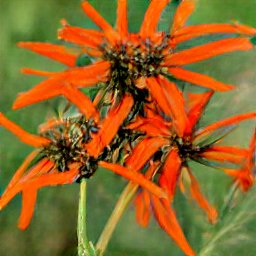Learn all about leonotis nepetifolia or commonly known as wild daggas or klip dagga or lions ear or lions tail.
When i was in Africa on a shamanic tour, i was introduced to a popular flowering herb called klip dagga or wild dagga. The plant is used to treat many ailments as well as being used as a mild psychotropic plant with effects similar in nature to cannabis. I got to learn a lot about Klip Dagga on this trip and i will share that information with you in this article.
Leonotis nepetifolia, Klip Dagga, Dagga Flower or Lion's Ear, is a member of the mint family. It is an evergreen perennial that grows best in USDA zones 9-11 but can be grown anywhere in the summer months. Klip Dagga is native to Africa and India. I have even seen it growing wild in Hawaii. This plant has an upright growth habit and produces light orange to red flowers. It is also a great source of nectar for honeybees.
 |
| Wild or Klip Dagga Lion's Ear Plant in Flower |
The flowers grow from ball shaped brackets right on the vertical stem and the leaves are smaller and green similar to a mint in shape. Leonotis nepetifolia is an annual plant that can grow up to 3 feet tall. It prefers full sun and can be grown in a wide variety of soils. Leonotis nepetifolia can be used in potpourri, bath products, and insect repellent.
It is most commonly used for its antispasmodic and nervine properties. The effects of Leonotis nepetifolia are used for conditions such as asthma, bronchitis, and coughing.
It is also used for nervousness, stress, and headaches. Leonotis nepetifolia has a long history of use as a medicinal herb. The plant is commonly used for recreational purposes and has been used for centuries in religious ceremonies.
Wild dagga flowers are the main parts used. But the whole Dagga plant has active ingredients so we use the whole plant.
I have got to try it both as a tea and in smoke form. The tea was brewed strong and i would say it is similar to valium and a bit stronger than chamomile. When i smoked it it was like a mild cannabis, very uplifting in it's effects.
Wild dagga effects
The effects of wild dagga vary depending on the dosage and method of consumption. Generally, wild dagga produces a feeling of relaxation and euphoria. Higher doses may produce hallucinations. The side effects of wild dagga are typically mild and may include dry mouth, nausea, dizziness, and sweating.
Klip dagga effects
Similar to wild dagga, the effects of klip dagga vary depending on the dosage and method of consumption. Generally, klip dagga produces a feeling of relaxation and euphoria. Higher doses may produce hallucinations. The side effects of klip dagga are typically mild and may include dry mouth, nausea, dizziness, and sweating. Wild
Dagga Plant
The plant can grow up to 3 feet tall and will perform best with good watering.
Klip dagga Seeds
Are available online. Try rareseeds.com
Klip dagga tea
Wild dagga can be consumed by smoking the dried leaves or brewing them into a tea.
Klip dagga Smoking or Smoking Klip dagga
The plant is often smoked, but can also be brewed into a tea.
